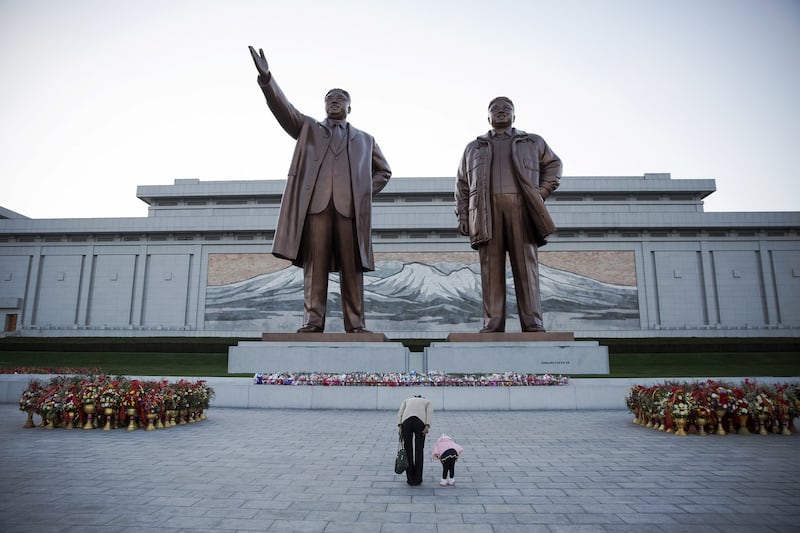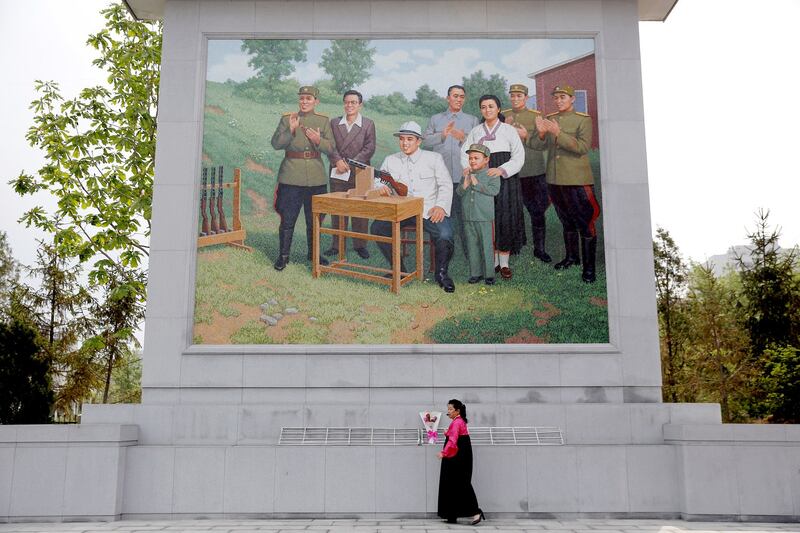A new luxury apartment complex built over the former residence of North Korea’s founder Kim Il Sung is seen by citizens as an example of third-generation leader Kim Jong Un trying to erase parts of his grandfather’s legacy, sources in the country told RFA.
The cult of personality surrounding the Kim family has dominated North Korean culture for more than 50 years. The country is littered with monuments to Kim Jong Un’s grandfather, who ruled from 1948-94, and father Kim Jong Il, who ruled from the elder Kim’s death in 1994 until he died in 2011.
Portraits of the Communist world’s only hereditary leadership, both of whom enjoyed god-like status, adorn the walls of every building and home, and grand murals depicting their revolutionary exploits can be found in almost every major town and city in the country of 25 million people.
Places they visited for a few hours many years ago still maintain shrines commemorating the occasion, but sources told RFA’s Korean Service that the housing development going up on the national founder’s former residence was just one of many examples of Kim Jong Un de-emphasizing his grandfather’s significance.
“Terraced houses are being built on the banks of the Potong River, and they are being touted as an example of modern development in the Kim Jong Un era,” a Pyongyang resident told RFA Oct. 20.
The new riverside apartments are under construction over the site of a former residence used by Kim Il Sung in the 1950s to 1970s, referred to as “Mansion No. 5” by North Koreans.
“Many people find it difficult to understand why they are converting Kim Il Sung’s long time residence into a high-end residential district,” said the source, who requested anonymity for security reasons.
South Korea-based Yonhap News reported that the site had been left vacant after it was destroyed in 2009 -- until they started to build the new luxury apartments.
“As far as I know, Mansion No. 5 was where Kim Il Sung lived the longest. He was there from the 1950s until he moved to Kumsusan Palace of the Sun in 1977,” the source said, referring to the late national founder’s last residence, which was posthumously converted into a grand mausoleum to house his sacred remains.
Mansion No. 5 is also historically significant, according to the source, because it was a rare example of a luxurious villa built in a scenic spot constructed before 1980, when North Korea was rebuilding after the destruction of the 1950-53 Korean War.
“Many people do not understand the idea of building luxury apartments over an important Kim Il Sung historical site, especially when the country builds monuments and museums on places where Kim Jong Il or Kim Jong Un merely briefly visited,” the source said.
“I really wonder if it is more important to build apartments rather than other structures at this historic location,” said the source.
The current North Korean leader is not oblivious to the criticism over the project, and he addressed the controversy, according to the source.
“Kim Jong Un was concerned enough about public reaction, so he said, ‘It is a pity that I can’t show this place to the public by turning it into a revolutionary museum,’ after the media emphasized that it was a sacred historical site,” said the source.
“But they are turning it into a luxurious residential site overlooking the Potong River, where some high-ranking officials loyal to Kim Jong Un will live.”

The source also said Pyongyang’s new general hospital has received similar criticism, because the massive structure obstructs sight lines between the revolutionary site Mansudae Hill, and the Workers’ Party Foundation Monument.
The hammer, sickle and brush that make up the monument were intended to be visible from the hill across the Taedong River, where two 20-meter (21.8-yard) statues of Kim Il Sung and Kim Jong Un gaze upon the capital.
“As the hospital was built in the middle of the view,… Pyongyang’s scenery became meaningless,” said the source.
“The terraced apartments built on the site of Mansion No. 5 are referred to as ‘Kim Jong Un’s exhaustive efforts for the people,’ but it is clear that it’s just an attempt to erase all traces of Kim Il Sung,” said the source, who further explained that many in North Korea long for the days of his rule.
Another source, also a resident of the capital, told RFA that military academies named after Kim Il Sung’s extended family have curiously been renamed for important political figures not related to the Kim dynasty by blood.
“Kim Hyong Jik Military Medical University was renamed Yim Chun Chu Military Medical University,” said the second source.
Kim Hyong Jik was Kim Il Sung’s father, while Yim Chun Chu was a guerilla who fought against Japan’s 1910-45 colonial occupation of the Korean peninsula and later North Korea’s vice president.
Academies named for Kim Il Sung’s uncle Kim Hyong Gwon and brother Kim Chol Ju underwent similar changes, according to the second source, but those named after the national founder, and his first wife Kim Jong Suk, remain unchanged.
“This has not yet expanded to civilian society but if it does, the names of Kim Hyong Jik University of Education, Kim Chol Ju University of Education, and Kim Bo Hyon College [named after Kim Il Sung’s grandfather] are likely to change soon,” said the source.
“A few years ago, many people were puzzled when even the portraits of the ‘three generals’ on the signboard at the main gate of the Mansudae Art Studio disappeared,” the source said, referring to picture murals of Kim Jong Il as a child with his guerilla parents.

These types of changes point to a concerted effort by Kim Jong Un to de-emphasize the importance of his grandfather, according to the second source.
“It would be absolutely impossible to remove the name of the leader’s family from these military academies or to remove their portraits without the permission of the supreme leader,” the second source said.
“Very slowly and skillfully, but clearly, they are erasing the traces of Kim Il Sung. Normally, you would think that the grandson would not want to forget his father or grandfather, and strongly cultivate their legacies. It is really surprising and strange.”
Reported by Chang Gyu Ahn for RFA’s Korean Service. Translated by Claire Lee. Written in English by Eugene Whong.
